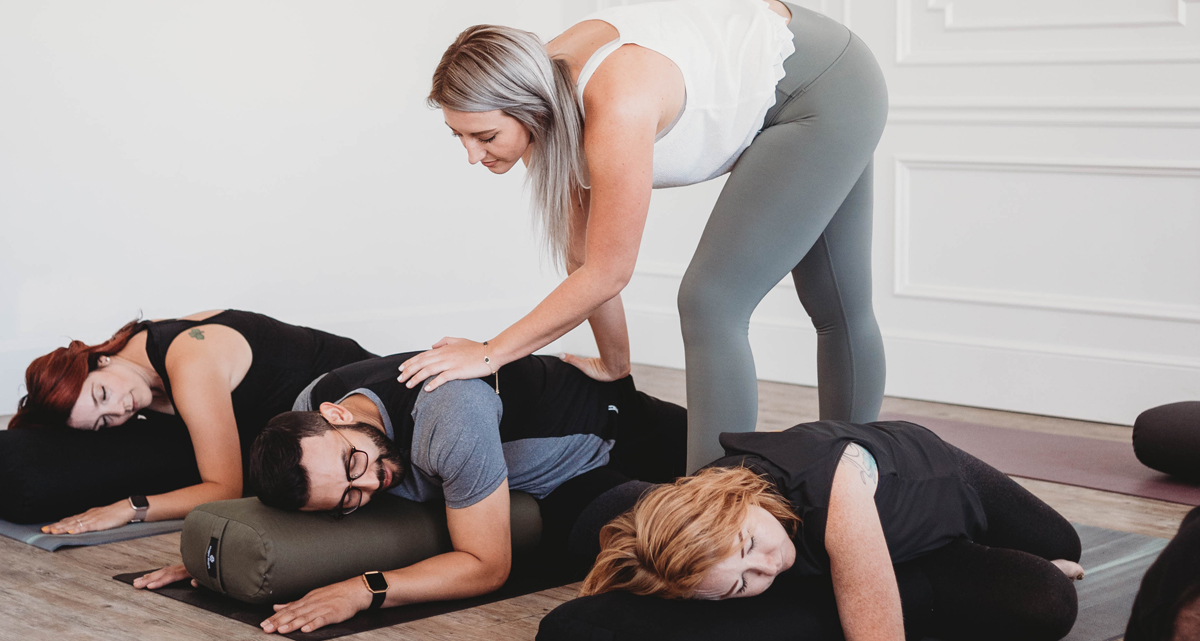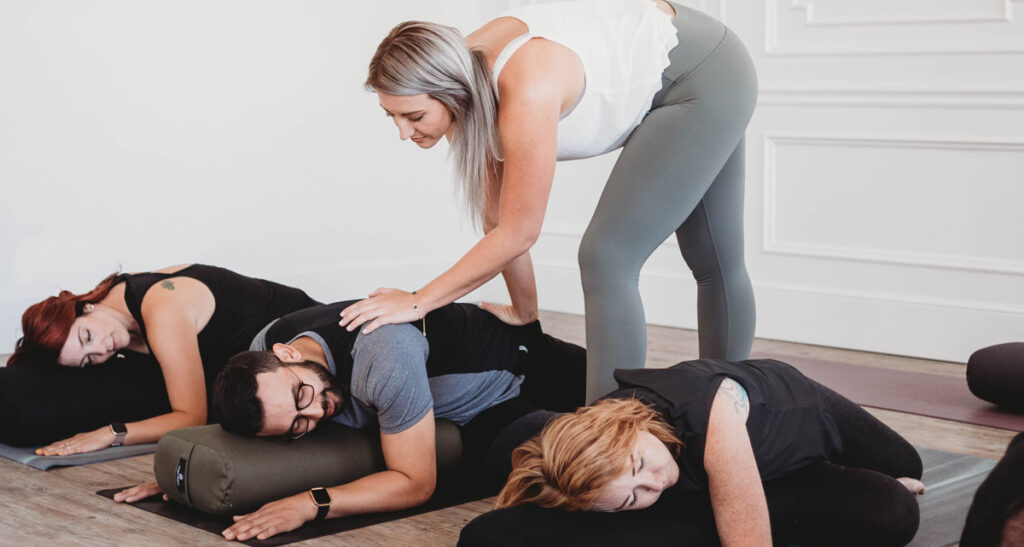This entry was posted on Jul 6, 2023 by Charlotte Bell.

Years in the past, considered one of my former college students took a yoga class at an area well being membership. My pupil had been training for a number of years and was fairly versatile in some areas of her physique; in others, not as a lot. The locations of inflexibility had been seemingly as a result of placement, depth and orientation of her hip sockets, which made her predisposed to inside, however not exterior, rotation.
The category was training Baddha Konasana (Sure Angle Pose). The pose requires quite a lot of abduction and exterior rotation. The trainer got here up behind my pupil and forcefully pushed her knees down towards the ground. In a shot heard ’around the classroom, a tendon snapped. My pupil was unable to stroll with out crutches for greater than a month.
Articles in nationwide media—together with The New York Instances and KQED, a Bay Space NPR station—have provoked full of life dialog within the nationwide yoga group. The articles element accusations of sexually inappropriate contact by well-known yoga academics within the identify of constructing guide changes. (I contributed my very own story of a groping incident by a well-known trainer to the KQED article.)
These incidents are a traumatizing abuse of energy, and exposing them has come none too quickly. Nonetheless, even when there is no such thing as a sexual intent, guide changes in yoga lessons should be undertaken with care and respect. There’s no indication that the trainer who snapped my pupil’s tendon had any type of malicious intent—sexual or in any other case—however the adjustment nonetheless brought on substantial hurt.
Why Give Handbook Changes?
Handbook changes are ubiquitous in lots of yoga lessons. There’s an affordable argument for giving yoga changes. When a pupil’s physique is misaligned in a pose, a guide adjustment may also help them really feel the distinction between wholesome and unhealthy alignment.
These changes require a trainer to have developed an eye fixed for studying cues which are usually delicate. This eye can take years to develop. For some college students, verbal directions will not be as relatable, and fewer skilled academics might not but have developed the language to speak verbal alignment directions successfully.
However many academics give guide changes with the intention to push college students additional into poses. As within the instance of my pupil and her snapped tendon, these changes have nice potential to trigger damage. They come up out of the mistaken notion {that a} robust asana follow means ignoring your physique’s indicators and pushing previous your edge.
As yoga follow has been transferred into Western tradition, its purpose has shifted from awakening via self-discovery to performing wonderful feats of flexibility. This has given rise to each acute and persistent accidents, in addition to to overly zealous academics pushing individuals previous their wholesome limits with the intention to make college students really feel as in the event that they’re “advancing.”
What Makes an Adjustment Acceptable—or Not?
Let’s break down the adjustment within the instance I gave initially of this text. What made this adjustment inappropriate?
Initially, the trainer walked up behind the scholar and pressed down on her thighs with out asking permission, and even making his presence identified. A lot of the time, we don’t know our college students’ histories. Many individuals have skilled previous trauma that could possibly be triggered by a guide adjustment, particularly when a trainer comes from behind and doesn’t talk his intentions.
Judith Hanson Lasater counsels academics to ask permission each single time they intend to make an adjustment. Even should you’ve adjusted an individual many occasions earlier than, it’s necessary to ask permission each time. Listed below are some strategies for how you can ask permission:
- “Would you be okay with me adjusting your alignment?”
- “Do you thoughts if I make an adjustment?”
- “Could I contact you?” (I’m not loopy about this one, however some academics discover it efficient.)
Some studios make use of consent playing cards that point out “sure” or “no” for guide changes. College students place these playing cards on their yoga mats.
The second challenge with the instance above is that the trainer tried to push the scholar’s physique additional into the pose. Changes that intend to pressure an individual right into a extra intense model of a pose are a recipe for damage. Even making an attempt to pressure a pupil’s physique into what we contemplate to be a better-aligned place may cause damage, as a result of there is no such thing as a alignment “rule” that matches each pupil.
Changes Are a Two-Means Road
Handbook changes are an artwork, and should be approached as a mutual exploration. We should develop the sensitivity to really feel when another person’s physique is receptive and when it isn’t. So the contact itself must be receptive, moderately than directive.
For instance, the trainer and pupil can embark on a gradual and mild exploration, the place there’s equality between trainer and pupil, moderately than a top-down assumption of trainer authority. Academics should be open to pupil suggestions—bodily and verbal. That is how we develop the attention that sees every pupil as a person, moderately than a cookie cutter whose poses “ought to” seem like some preconceived best.
Pupil Company
Yoga college students have energy as nicely. Particularly in case you are working with a trainer you don’t know nicely, you’ll be able to specific your company within the following methods:
- By declining guide changes, interval.
- By asking concerning the intention for an adjustment. If it’s to push you additional right into a pose, you’ll be able to determine whether or not you need to take the potential threat.
- By asking the trainer to maneuver slowly, and to hearken to your suggestions.
Asana is a bodily follow. However it’s so far more. Our bodily, psychological, emotional and non secular experiences are saved in our our bodies. There are causes practitioners select to carry again of their poses. Generally it’s not a alternative; their buildings are merely not designed for sure actions. If we would like our instructing follow to develop, we have to be open to letting our college students educate us.
About Charlotte Bell
Charlotte Bell found yoga in 1982 and commenced instructing in 1986. Charlotte is the writer of Aware Yoga, Aware Life: A Information for On a regular basis Observe and Yoga for Meditators, each revealed by Rodmell Press. Her third guide is titled Hip-Wholesome Asana: The Yoga Practitioner’s Information to Defending the Hips and Avoiding SI Joint Ache (Shambhala Publications). She writes a month-to-month column for CATALYST Journal and serves as editor for Yoga U On-line. Charlotte is a founding board member for GreenTREE Yoga, a non-profit that brings yoga to underserved populations. A lifelong musician, Charlotte performs oboe and English horn within the Salt Lake Symphony and folks sextet Pink Rock Rondo, whose DVD gained two Emmy awards in 2010.

